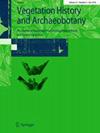Predynastic and Early Dynastic plant economy in the Nile Delta: archaeobotanical evidence from Tell el-Iswid
IF 1.9
2区 地球科学
Q1 PALEONTOLOGY
引用次数: 0
Abstract
Abstract The large-scale excavation at the prehistoric site of Tell el-Iswid made it possible to undertake a systematic archaeobotanical study of different structures covering the Predynastic and Early Dynastic period (Lower Egyptian Cultures, i.e. Buto II (3500−3300 bc ) to Naqada III Culture (3300−2900 bc )). Here we present the results of the analysis of carpological remains preserved mostly in a charred state and coming from 62 samples processed by manual flotation, with total volume of 615 L and containing a total of 9,672 identifiable and quantifiable items. A further ca. 650 wood fragments (or woody vegetative remains) were subject to anthracological analysis. Besides the aim of overall characterisation and exploration of the plant economy of the site, the macrobotanical assemblages were also considered in relation to the structures from which they were uncovered. The study revealed that the agricultural economy of both studied periods relied on emmer, barley, lentils, and pea, but from Early Dynastic times onwards barley and pulses gained more importance, along with flax ( Linum usitatissimum ) and condiments (like Anethum graveolens and cf. Origanum sp.), which occur first during this period at the site. Together with the cultivated fields, the surrounding wetlands were also an important part of the plant resources utilized at the site. The stems of Phragmites are the most common among the anthracological remains, together with a small proportion of Tamarix and Acacia charcoal fragments. The overall composition of the plant assemblages (charred and mineralised chaff, small weed or wild growing seeds capable of passing herbivore digestion, dung fragments, awns) suggest that the major source of the retrieved plant remains was dung fuel.尼罗河三角洲的前王朝和早期王朝植物经济:来自Tell el-Iswid的考古植物学证据
Tell el-Iswid史前遗址的大规模发掘使得对涵盖前王朝和早期王朝时期(下埃及文化,即Buto II(公元前3500 - 3300年)至Naqada III文化(公元前3300 - 2900年))的不同结构进行系统的考古学研究成为可能。在这里,我们展示了对62个人工浮选样品中大部分以烧焦状态保存的地质遗迹的分析结果,这些样品的总体积为615 L,共包含9,672个可识别和可量化的项目。另有约650块木片(或木本植物残骸)进行了人类学分析。除了全面描述和探索该遗址的植物经济外,还考虑了与它们被发现的结构相关的大型植物组合。研究表明,两个研究时期的农业经济都依赖于小麦、大麦、扁豆和豌豆,但从早期王朝时期开始,大麦和豆类变得更加重要,同时,亚麻(Linum usitatissimum)和调味品(如Anethum graveolens和cf. Origanum sp.)也在这一时期首次出现在该遗址。除耕地外,周边湿地也是基地利用植物资源的重要组成部分。芦苇的茎是最常见的,还有一小部分柽柳和金合欢的木炭碎片。植物组合的整体组成(烧焦和矿化的糠,能够通过食草动物消化的小杂草或野生种子,粪便碎片,芒)表明,回收的植物遗骸的主要来源是粪便燃料。
本文章由计算机程序翻译,如有差异,请以英文原文为准。
求助全文
约1分钟内获得全文
求助全文
来源期刊
CiteScore
5.30
自引率
8.00%
发文量
32
审稿时长
>12 weeks
期刊介绍:
Vegetation History and Archaeobotany publishes research papers, review articles and short contributions of high quality from Europe, the Americas and other parts of the world. It covers the entire field of vegetation history – mainly the development of flora and vegetation during the Holocene (but also from the Pleistocene), and including related subjects such as palaeoecology. Of special interest is the human impact upon the natural environment in prehistoric and medieval times; this is reflected in pollen diagrams as well as in plant macroremains from archaeological contexts.

 求助内容:
求助内容: 应助结果提醒方式:
应助结果提醒方式:


